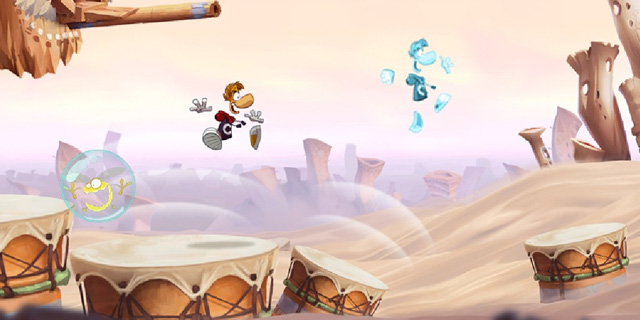
Ever since those crazy Rabbids took over, the Rayman series has been pushed to the side as if it never mattered in the first place. With Rayman Origins, the limbless hero returns with his first 2D outing since the original Rayman back in 1995. Many of the elements that made that game stand out back then apply here: it’s whimsical, addictive, and very French. And trust me, that’s a very good thing.
It’s hard to talk about Rayman Origins without mentioning its gorgeous art design. Everything from the design of the enemies, the environments, the animations, and even Rayman and his friends themselves all look incredible. This is one of the most visually striking 2D games you will ever see, and simply watching videos of it does not do it justice. It looks great on the Vita’s high-res screen. Combine that with the soundtrack, which features some songs that will be stuck in your head for days, and it’s just a charming package all around.
That’s all well and good, but none of it matters if you don’t have a compelling game to go along with it. Thankfully, Rayman Origins delivers on that front in every way imaginable. The controls are easy to pick up and learn and feel very responsive, and some of the later abilities you will learn really help add to that fluidity of motion. You never feel like you missed a jump or a platform because of the handling of the character or the way the levels were designed, it all feels just right.
There is also plenty of variety in both the levels and the gameplay. Although in the second half of the game you find yourself revisiting some of the same locations, the actual levels feel as fresh as ever. They are all laid out in such a careful manner that allows for both speeding through them and also exploration, which is the sign of a good platformer. You might stumble a few times, but you never feel lost and always have a clear idea of where to go next.
As you go through levels, you’ll be picking up things called Lums; get enough of these to earn Electoons, which are the main collectible in the game. You also get Electoons through cages that are in each level. Most levels have three cages to find, one at the end and two hidden. The Lums and hidden cages are scattered throughout the levels in a meaningful way that really makes replaying areas just as fun as the first time through.
There are also shooter levels in which you ride a giant mosquito and take down enemies, earning Lums as you do. Like in the original Rayman, these levels are a larger part of the game than you might expect and are just as fun. There are also the boss encounters, which offer a lot of variety as well. Some have you chasing the bosses down through an obstacle course while others will have you trying to destroy the boss from the inside out, literally. These sections aren’t introduced until the second half but they add a surprising amount of challenge to the game.
Speaking of challenge, Rayman Origins is not exactly an easy game. Well, it is at first. The first four worlds are there to introduce new mechanics to the players slowly, giving them plenty of opportunities to get the hang of them. Once you get passed that point, things can get pretty tough, but they are never frustrating. Some of the later levels require such precise timing that could take a while to truly get down, but it’s a refreshing build up you rarely see in games these days.
Unlike the console versions, there is no co-op to be found on the Vita. It wasn’t really a focus or game-changer on consoles though, so it’s not a great loss. As it stands, Rayman Origins is a solo adventure through and through. Ubisoft did add in a new Ghost mode, which allows you to chase runs of yourself and friends and beat the time.
It’s not so often when we get a new 2D platformer these days; each new release in the genre should be treasured, especially if they are worth playing. Thankfully, Rayman Origins is one of the most delightful games you’ll play all year and deserves a place in the collection of any platformer fan.
Staff writer Shawn Vermette contributed to this review.
Pros: Stunning visuals and catchy music, fluid controls, excellent level design
Cons: No co-op like its big-screen brethren



















